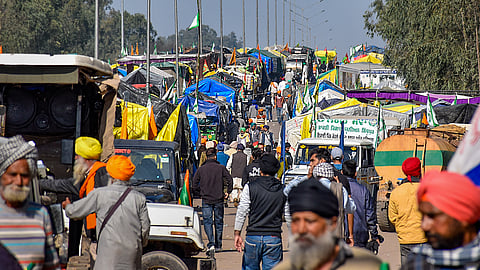

Storm clouds are building up at the gates of Delhi. Farmers from Punjab and Haryana have resumed their march after four rounds of talks with the Union government have yielded no settlement. Things have taken a plunge for the worse after the strongarm tactics of the Haryana police – shooting teargas and firing rubber bullets – claimed the life of a youth, Shubh Karan Singh, at the Kanauri border.
One can see the contours of the agitation quickly widening as the stalemate worsens. Initially started by a dozen or so Punjab-based kisan and farm workers unions for pressing the demand for minimum support price (MSP) and debt waiver, the protests have now drawn in the 2021 protest apex group, the Samyukta Kisan Morcha (SKM), after the death of the young farmer.
A national ‘tractor rally’to jam highways has been announced for 26 February followed by a ‘Mahapanchayat’ of farmers in Delhi on 14 March. The farmers leaders have learnt their lessons from the 2021 agitation and have decided not to accept half measures. They also know it’s the runup to the Lok Sabha elections, and it is best to strike when the iron’s hot.
Unremunerative prices
The current round of farm protests are a continuum of the 2021 agitations that resulted in the repeal of the 3 farm laws. The farmers saw the Union government’s laws as a bid to bypass the ‘mandi’ system that provided both price support and loans at the time of crisis. The laws were seen as an attempt by financial groups to ‘corporatize’ agriculture and take over the production and distribution of farm produce.
This round of protests has raised a more fundamental issue – the distress caused by unremunerative prices. That is why the demand for legislation validating a minimum support price (MSP) for not just rice and paddy, but for a spectrum of 23 crops, is central to the current agitation.
The problem of unremunerative prices and the need for an MSP system rears its head every now and then. It was well articulated more than 4 decades ago by the Maharashtra farm leader Sharad Joshi who formed the Shetkari Sanghatana to demand remunerative prices for a variety of crops. Pitching the problem as a Bharat-versus-India contradiction, he said Urban India,using its political and financial clout, exploited and colonized the rural hinterland through layers of middlemen. He thus demanded direct access to both local and international markets for farmers so that they reap the intrinsic worth of their crops.
In the current imbroglio, the two main stumbling blocks seem to be – First, the government wants to limit MSP cover to pulses, maize and cotton crops apart from paddy and rice, while the farmers leaders want a spectrum of 23 crops included that are subject to high market volatility.
Second, the government has failed to address the key demand of calculating MSP using the formula C2+50 percent, which includes cost of production plus the input value of family labour and the rental value of owned land and interest on fixed capital. This was recommended by the MS SwaminathanCommission as a measure to tackle rural distress. The current MSP formula A2+FL reduces prices by upto 30 percent, farmers leaders say.
The other key demand is for an across-the-board waiver of loans to farmers and agricultural labour. These loans have had a crushing effect on family income and have been the main cause of the continuing suicides among farmers.
Teargas and bullets
The woes of India’s farmers are not unique. Agriculture across the world had become less remunerative with increasing input costs, fewer subsidies and falling prices. France, one of Europe’s biggest agricultural producers, has been shaken by farmer protests over the last two months. They have jammed highways and dumped their products on Paris’ pretty streets to raise concerns about competition from cheaper imports, and environmental laws that have made input costs more expensive. Farmers in Italy, Spain and Poland too have been on the warpath.
What is however striking is the difference in the way farmers protests are handled in say France as compared to India. French farmers’ tractors can enter Paris, and they can stage their protests including block roads and highways as long as they don’t turn violent. This is quite at variance with the teargassing with drones, firing on farmers and policemen erecting cement barricades and planting giant nails on the roads to prevent the protestors from reaching Delhi.
The long hand of the Union government has also extended to gagging social media content. ‘X’ formerly twitter has admitted to taking down both accounts and posts, especially those supporting the farmers cause, following ‘executive orders’ of the government. X said it disagreed with these actions as they were violative of the ‘freedom of speech’ but had no alternative as it was “subject to potential penalties, including imprisonment.”
While there are government appeals for resuming talks, on the ground the gloves are off and the sledge hammer is coming down. Punjab’s farmers are caustically referred to as ‘Khalistanis’. One can differ about their demands, and their methods, but the right of farmers to peacefully protest cannot be crushed. What we have seen in the last few days does not bode well for an early settlement.